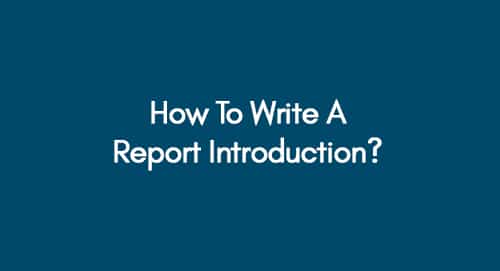
How to Write a Self-Reflection? Practical Tips for Success
October 12, 2022
How to Write an Exceptional Lab Report? A Sequential Handbook
October 12, 2022Are you working on a report and struggling to write an engaging introduction? Do you want to know how to hook your readers and make them want to read your entire report? To better understand the concept of report introduction writing, visit the following link;
Review Introduction in Complete Dissertation Examples Here
In this step-by-step guide, we'll teach you how to write a report introduction that will get your readers excited about what's to come. It is a skill; mastering it can be the difference between a good and bad report.
What is a Report?
A report is an academic document that contains data or findings from an investigation. Reports are usually used to communicate the results of a business project, scientific study, or research effort. Reports typically include a section of the executive summary, followed by sections that provide more detailed information.
Explore What is the Goal of Report Writing Here
The length and format of a report vary depending on its purpose and audience. For example, an annual report for shareholders will be very different from a scientific one. Ultimately, the goal of any report is to provide clear and concise information about a particular subject.
Structure of a Report
The structure of a report is very important in report writing conventions. The structure of a report is as follows.
1. Introduction
The introduction is the first section of a report and sets the tone for the rest of the document. The main objective of an introduction is to introduce your topic and get your readers interested in what you have to say.
2. Executive Summary
The executive summary is a short, concise overview of the findings or conclusions presented in a report. It's typically one or two paragraphs long and should be written last.
3. Body
The body of a report contains all the detailed information about your topic. It can be divided into subsections if needed.
4. Conclusion
The conclusion wraps up the information presented in the body of the report and offers some final thoughts on the subject matter.
5. Appendices
Appendices are optional sections that contain additional information related to your topics, such as charts, graphs, tables, images, or data sets.
Role of Introduction in a Report
The purpose of an introduction in an academic report is to offer a clear, concise overview of the main points the report will address.
The introduction of a report is critical as it sets the stage for the rest of the report and provides your readers with a framework to understand your findings.
Learn More about What should Keep in Mind While Writing Introduction
It is important to remember that the introduction is not meant to be exhaustive; instead, its goal is to give the reader a basic understanding of what the report will cover.
It should state the overall purpose or goals of the report. It must provide a brief overview of the methods used to gather information and data for the report. Finally, the introduction should briefly touch on the key findings or takeaways from the report. By including these elements, you can ensure that your readers clearly understand your report's core.
Characteristics of a Well-Written Report Introduction
- The introduction should convey the purpose of the report.
- The introduction should provide an overview of the report's key points.
- The introduction should clarify why the topic is necessary or relevant.
- The introduction should define any key terms used in the report.
- The introduction's purpose is to set the tone for the rest of the report.
- The introduction should clarify what the reader can expect to find in the report.
- The introduction should be well-organized and easy to follow.
- The introduction should be no more than one or two paragraphs long.
- The introduction must end with a clear statement of the report's thesis or main argument.
Components of a Well-Written Introduction
There are three parts to a well-written introduction:
- The hook
- The transition
- The Scope
The hook grabs the reader's attention with a brief report overview. The transition briefly explains how the hook relates to the rest of the report. The scope statement clearly and concisely states the report's leading authority.
Here's how to craft various parts of the introduction:
1. The Hook
The first part of a well-written introduction is the hook. The hook grabs the reader's attention and gives them a reason to keep reading. It can be a crucial statistic, important background information, and an overview of the topic in consideration.
2. The Transition
The second part of a well-written introduction is the transition. The transition connects the hook to the purpose of the report. In this part, write about what to expect from the report.
3. The Scope
A well-written introduction's third and final part describes the report's scope. You should briefly discuss the data collection methods, analysis, and results of the report.
Steps of Writing a Report Introduction
1: Introduce the Topic of the Report
Present your report's topic and explain it briefly to familiarize the reader with the topic of the report. The concise way to introduce it is by explaining the background of the title and elaborating on the outcome.
2. Summarize the Main Points Covered in the Report
In the second step, provide a summary of your key points, sections, results, and discussions of the report.
You can use a summarizing tool to execute this step, as it efficiently grasps the key points from your report and presents them in a paragraph or bullet form, as per your requirements.
3. State the Purpose of the Report
Step 3 should describe the aim and purpose of your report. Use concise language and expressive verbs. Avoid jargon, ambiguities, and technical complexities early in your report.
4. Preview the Main Findings of the Report
In the final step of your report introduction, tell your readers what results you gained and what are the report's primary findings.
Template of the Report Introduction
You can follow this template to craft a concise and crisp introduction to your report.
"The purpose of this report is to (explain what the report will be about). This report will (give an overview of what the report will cover). The methodology used in this report is (explain how the report was created). The findings of this report are based on (describe what the report found). This report concludes with (give a summary of the report's conclusions)."
Conclusion
To conclude, writing a report introduction can make or break your complete report analysis. Therefore, the said recommendations must be followed to stand out in your report writing.
If you're looking for help writing a report, Premier Dissertation can provide you with the expert assistance you need. We have years of experience assisting students in writing clear, concise, and well-organized reports.
Some more resources are provided below to ace report introduction writing;
Get 3+ Free Dissertation Topics within 24 hours?



























